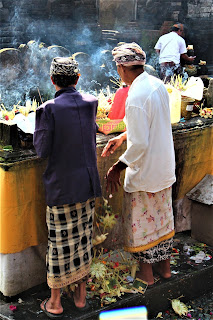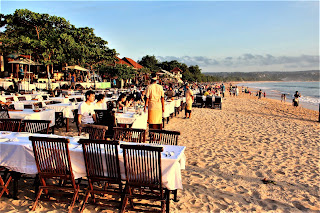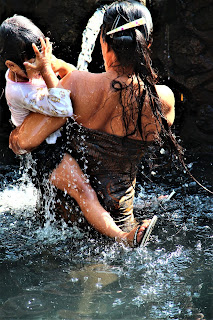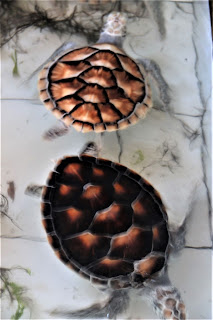Touring the un-Indonesian-like island of Bali in 2012
(Travel Story series @ Hon Too Fang 2020)
In May 2012 four senior couples lead by a young lady, went to Bali to "lepak" for a few days. For me it was a second visit after a lapse of some 20 years. Not much has changed except the traffic jam. This is a photo story of the un-Indonesian-like island.
Bali is a province of Indonesia, the biggest Muslim country in the World by population, yet the Balinese are essentially Hindus, with their unique culture. Hence un-Indonesian-like. Bali has a recorded history dated to the 9th century, and was mostly governed by Hindu kingdoms. The Balinese people are closely linked to others in this region, meaning they look like other Indonesians. Shown the typical attire of the Balinese.
In Bali we stayed in a chalet hotel in Ubud, a town located amongst rice paddies in the central foothills of the island. It is being promoted as an arts and culture centre. Shown a street in town and our hotel ground, more reposeful than Denpasar the capital or Kuta at the beach.
(1) Face of Bali: Dvarapada and other gods
Bali has a population of some 3.9 million, roughly 90% of them Hindus. The Dvarapada are guardians of the Hindu temples and other sacred places, even residences. They are ubiquitous and most noticeable because there are some 20,000 temples in this "Land of Thousand Gods".
Then we have the Hanuman or Monkey God and Ganesh the Elephant God. Sandwiched in between is a sexy one, may be the God of Fertility?
(3) Tower of Bali: the pagoda tower
The pagoda-like multi-tier-roof tower is the distinctive feature of the Balinese temples. Shown temples at Taman Ayun and the Bedugul Resort.
(4) Umbrella of Bali: the parasols
Parasols are umbrellas with more delicate fabrics, with laces, etc. Many of them are used to "protect" the outdoor altars. And a 3-tier one is strictly meant for a king. Look at the 3rd photo. Who is the king that commands a 3-tier red parasol? Oh, a herd of pigs in Muslim Indonesia are the royal family. In Bali one of the famous local dishes is "babi guling" like the "suckling pig" in a Chinese restaurant in Malaysia. This parasol is found at the entrance of a famous babi guling restaurant.
(5) Religion of Bali: 3-in-1 for convenience?
Hinduism worships a multitude of deities. There is a small ethnic Chinese community here who were originally Taoists/Buddhists. So what are they now in Hindu Bali? Well they adapted and became Hindu-Taoist-Buddhists! Things 3-in-1 are popular for the convenience. I take 3-in-1 white coffee. This altar in a shop run by such a 3rd generation Chinese family has 2 levels: upper one for Buddhist and Taoist deities, and the lower one for Ganesh, the elephant god in Hinduism. The red Chinese joss sticks are used for the Hindu Ganesh. In the 2nd photo, the Guan Gong Temple 关公庙 is guarded by some Hindu deities. Guan Gong is a deified Chinese warrior who lived some 1,800 years ago.
3-in-1 only in Bali.
(6) Gate of Bali: the Split Gate
The structure of the main gate of a Balinese temple is almost always split in the middle, giving form to the Split Gate, the candi bentar. It symbolises a mountain split into two, a unique Balinese building feature adopted from Indian Hinduism. Then we also have the paduraksa, intricately carved gate (with a roof) which serves as entryway to a family compound, or a big compound, 4th photo.
(7) Dance of Bali: the Barong dancers
Bali is renowned for its diverse and sophisticated art forms, such as painting, sculpture, woodcarving, and performing arts. And the Barong dance is one of the most innovative and popular. It is about the good and the evil, performed in elaborate and glamorous costumes. We saw that some 20 years ago and didn’t watch that this time. Here little girls in plain T-shirts are practising to be the star dancers.
(8) Crafts of Bali: the wood and stone carving
Bali is famous for its carving work, in metal, wood as well as stone.
(9) Taxi of Bali: the open-top one
Bali's weather is like Kuala Lumpur, hot and humid. But the Aussies like it and Australia is the number one nation supplying tourists to Bali. So they have such open-top see-all taxis for the Aussies to enjoy their sun bathing while caught in the traffic jam in Ubud.
(10) Police of Bali: feminine power
Saw this police van near the famous temple at Tanah Lot. Look like the Balinese police banks on the feminine power to serve and protect. The Malaysian police force is of course more expert in the use of water cannons and firing tear gas!
(11) Future of Bali: what a name for a shop
In Ubud you can buy anything. You want a Ticket to the Moon, no problem too.
(12) Feast of Bali: candle-light dinner at the beach
We had a seafood dinner at Jimbaran Bay. A stretch of several km of the sandy beach is lined with dining tables. Wonder if we have such facility on our Malaysian beaches.
(13) Beauty of Bali: nice and pleasing settings
Showing tranquillity and peace.
(15) Villain of Bali: the Falun Gong
What kind of vehicle is this: pasted with so many slogans? Some more written in Chinese? Got license for the ad eh? Well, this is a van I saw in busy Ubud owned by the Falun Gong group. Falun Gong is a qigong group originated in mainland Chinabut since has been outlawed. The leader claims that he is the most "powerful" reincarnated Buddha. He was said to have amassed a fortune and escaped to the US. But the sect is active elsewhere. The posters curse China and praise Taiwan. Has politics anything to do with qigong? Saw a dozen of the gang members practising in public, the command of the routine from a recorder was in Mandarin.
(16) Charm of Bali: Ulun Danu Beratan Temple
A beautiful shot of the photogenic Ulun Danu Beratan Temple at the Bedugul resort. This is the Bali for the typical tourist.
(17) Sun-set of Bali: Tanah Lot
Tanah Lot is one of the most famous temples in Bali, literally it means "Land in the Middle of the sea". Big crowd come to witness the famous sun-set scene.
(18) Cleansing of Bali: dip at the Tirta Empul Temple
The main attraction of this large temple is a main pool carved of stone, fed by a sacred spring via 12 fountains. Worshipers make an offering, then dip into the pool to be cleansed.
Tirla Empul Temple
This Hindu temple was first founded in 962, built as a spiritual purification centre because of the large spring there. Shown in (18) earlier. In fact Tirla Empul means Holy Spring in Balinese. A rather big complex with several pools and over 30 shower heads. There is a very elegant timber pavilion.

Tanah Lot Temple
Tanah Lot is a temple famous for sun-set scenery and photography, explained in (17). It was built around the 16th century, and is one of the 7 sea temples along the coast. The rock face of this temple which has been crumbling was repaired by Japanese funding in the 1980s. The “sea” of coconut resemble what we find during our Thaipusam in Batu Caves.
Uluwatu Sea Temple
This is a sea temple located at the edge of a 70-m cliff and founded in the 11th century. The cliff is said to be the petrified barque of a certain sea god. The temple itself is very run-down. This place is infamous for the monkeys stealing or robbing tourists’ bags, glasses, etc.
Kintamani
Kintamani is a highland region in north eastern Bali at the Mount Batur caldera. It is about 1,500 m above sea level, and offers dramatic views of the active volcano Mount Batur.
Bedugul Resort
Bedugul is a mountain lake resort in central-north Bali. The lake is called Beratan Lake, with the iconic Ulun Danu Beratan Temple on its western shore. A popular location of wedding photo shoot for Malaysians and Singaporeans.
Turtle Island at Tanjung Benoa
Turtle Island is not an island, but a beach at the southern tip of the main island of Bali. It has a Turtle Conservation and Education Center for the endangered green turtle. We took a half-day tour to this place, first hour on a glass-bottom boat to watch some fishes in their natural habitat. The beach is also a venue for water and “sky” sports. Only a 2-star attraction for seniors.
Coffee farm
Visited a coffee farm on the highland and tasted the famed luwak coffee. Luwat coffee is a coffee that consists of partially digested coffee cherries, which have been eaten and defecated by the Asian palm civet, a cat-size animal. It is the most expensive coffee in the World. The one we had was tasteless. From the low price we paid, about 3 times normal coffee, it is most likely a tourist scam, or a greatly diluted mix.
(20) Farewell to Bali: Remark
Bali has always been voted among the top 3 or top 5 island attractions in the World. Its diverse un-Indonesian-like culture is fascinating. It is a place worthy for a visit if you have not been there, and worthy of a re-visit if you have been there! Bali always wins!
Two group photos: one at Kintamani and the other at the Tirta Empul Temple (BH missing)
(First written in the email format in June 2012. Revised in March 2016. Further revised to this PDF format in November 2020)


































































No comments:
Post a Comment